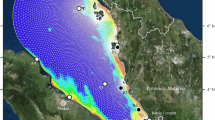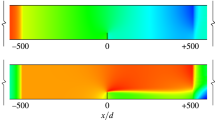Abstract
Tidal power potential is determined across the Western Passage in Passamaquoddy Bay using the Finite Volume Community Ocean Model (FVCOM). The tidal turbines are implemented in FVCOM using the disc actuator theory method to determine the power potential for different densities and arrangements of tidal turbines. At the most efficient setting for 10 turbines across the Western Passage, the optimal turbine drag coefficient is 2.0 and the average power output, in a 2-week period, is ∼819 kW. Results suggest that for a single row of turbines, the addition of turbines decreases the efficiency of the turbine farm, but this decrease in efficiency is less than 7 %. A parallel distribution of turbines in an array diminishes the average power for turbines in the shadow of other turbines, while staggered distribution in an array increases the average power extraction for some turbines, due to the speed gains in the gaps between turbines. A simple tidal farm optimization using the OpenTidalFarm (OTF) model suggests a similar tidal farm distribution.














Similar content being viewed by others
References
Bao M (2013) Tidal Turbine Array Optimization - using the Quoddu regions as an example, PhD thesis, Ocean University of China
Betz A (1920) Das maximum der theoretisch mglichen ausnutzung des windes durch windmotoren. Z Gesamte Turbinewesen 17:307–309
Blanchfield J, Garrett C, Rowe A, Wild P (2008) Tidal stream power resource assessment for Massett Sound, Haida Gwaii. J Power Energy 222(5):485–492
Brooks DA (2006) The tidal-stream energy resource in Passamaquoddy-Cobscook Bays: a fresh look at an old story. Renew Energy 31(14):2284–2295
Cameron M (2012) Flow field measurements for cross-field turbines. Master’s thesis, University of Maine
Chen C, Beardsley R (2003) An unstructured grid, finite-volume, three-dimensional, primitive equations ocean model: application to coastal ocean and estuaries. J Atmos Ocean Technol 20:159–186
Chen C, Cowles G, Beardsley R (2006) An unstructured grid, finite volume coastal ocean model: FVCOM user manual 2nd edn. Technical report, SMAST/UMASSD Technical Report -06-0602
Chen C, Huang H, Beardsley RC, Liu H, Xu Q, Cowles G (2007) A finite volume numerical approach for coastal ocean circulation studies: comparisons with finite difference models. Journal of Geophysical Research: Oceans 112(C3):n/a–n/a. C03018
Chen C, Huang H, Beardsley RC, Xu Q, Limeburner R, Cowles GW, Sun Y, Qi J, Lin H (2011) Tidal dynamics in the gulf of Maine and New England shelf: an application of FVCOM. Journal of Geophysical Research: Oceans 116(C12):n/a–n/a. C12010
Defne Z, Haas KA, Fritz HM (2011) Numerical modeling of tidal currents and the effects of power extraction on estuarine hydrodynamics along the Georgia Coast, {USA}. Renew Energy 36(12):3461–3471
Dupont F, Hannah CG, Greenberg D (2005) Modelling the sea level of the upper Bay of Fundy. Atmosphere-Ocean 43(1):33–47
Funke S, Farrell P, Piggott M (2014) Tidal turbine array optimisation using the adjoint approach. Renew Energy 63:658–673
Garrett C, Cummins P (2004) Generating power from tidal currents. J Waterw Port Coast Ocean Eng 130(3):114–118
Garrett C, Cummins P (2007) The efficiency of a turbine in a tidal channel. J Fluid Mech 588:243–251
Greenberg DA, Shore JA, Page FH, Dowd M (2005) A finite element circulation model for embayments with drying intertidal areas and its application to the Quoddy region of the Bay of Fundy. Ocean Model 10(12):211–231. The Second International Workshop on Unstructured Mesh Numerical Modelling of Coastal, Shelf and Ocean Flows
Hasegawa D, Sheng J, Greenberg D, Thompson K (2011) Far-field effects of tidal energy extraction in the Minas Passage on tidal circulation in the Bay of Fundy and Gulf of Maine using a nested-grid coastal circulation model. Ocean Dyn 61(11):1845–1868
Karsten RH, McMillan JM, Lickley MJ, Haynes RD (2008) Assessment of tidal current energy in the Minas Passage, Bay of Fundy. Proc IME A J Power Energy 222(5):493–507
Lynch DR, Naimie CE (1993) The M2 tide and its residual on the outer banks of the Gulf of Maine. J Phys Oceanogr 23:2222–2253
McMillian J, Lickley M (2008) The potential of tidal power from the Bay of Fundy. Society of Industrial and Applied Mathematics
Mellor GL, Yamada T (1982) Development of a turbulence closure model for geophysical fluid problems. Rev Geophys 20(4):851–875
Plew DR, Stevens CL (2013) Numerical modelling of the effect of turbines on currents in a tidal channel—Tory Channel, New Zealand. Renew Energy 57:269–282
Roc T, Conley DC, Greaves D (2013) Methodology for tidal turbine representation in ocean circulation model. Renew Energy 51:448–464
Smagorinsky J (1963) General circulation experiments with the primitive equations. Mon Weather Rev 91:99
U.S. EIA (2014) Annual energy outlook. Technical report, U.S. Energy Information Administration
Vennell R (2010) Tuning turbines in a tidal channel. J Fluid Mech 663:253–267
Vennell R (2011) Tuning tidal turbines in-concert to maximise farm efficiency. J Fluid Mech 671:587–604
Vennell R (2012) Realizing the potential of tidal currents and the efficiency of turbine farms in a channel. Renew Energy 47:95–102
Vennell R (2013) Exceeding the Betz limit with tidal turbines. Renew Energy 55:277–285
Xu D, Xue H (2011) A numerical study of horizontal dispersion in a macro tidal basin. Ocean Dyn 61(5):623–637
Xu D, Xue H, Greenberg D (2006) A numerical study of the circulation and drifter trajectories in Cobscook Bay, chapter 11, pp 176–195. American Society of Civil Engineers
Xue H, Bao M, Bao X, Cameron M (2013) A numerical study of tidal farm efficiency in the Western Passage, US and Canada. In: OCEANS - Bergen, 2013 MTS/IEEE, pp 1–10
Yang Z, Wang T, Copping AE (2013) Modeling tidal stream energy extraction and its effects on transport processes in a tidal channel and bay system using a three-dimensional coastal ocean model. Renew Energy 50:605–613
Acknowledgments
The authors would like to thank Steve Cousins from the University of Maine for his assistance in coding and setting up our numerical experiments. The work is supported by the Department of Energy award number DE-EE0000298 and Argonne National Laboratory contract number 3F-30543 to the University of Maine.
Author information
Authors and Affiliations
Corresponding author
Additional information
Responsible Editor: Jinyu Sheng
This article is part of the Topical Collection on the 6th International Workshop on Modeling the Ocean (IWMO) in Halifax, Nova Scotia, Canada 23-27 June 2014
Rights and permissions
About this article
Cite this article
Rao, S., Xue, H., Bao, M. et al. Determining tidal turbine farm efficiency in the Western Passage using the disc actuator theory. Ocean Dynamics 66, 41–57 (2016). https://doi.org/10.1007/s10236-015-0906-y
Received:
Accepted:
Published:
Issue Date:
DOI: https://doi.org/10.1007/s10236-015-0906-y




